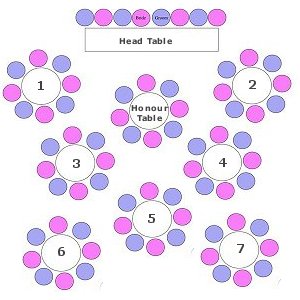 |
WeddingConnexion.com |
| WEDDING RECEPTION - Tips & Tricks |
 |
Planning a formal seating plan for your wedding reception will help reduced your stress level. Simply providing enough tables and chairs for everyone and hoping for the best is not enough. It will create tension amongst guests to rush to find themselves the perfect table. If you are hosting a cocktail or buffet style reception, without formal seating ensure you designated section for elderly guests. To get you started on creating a seating plan, get a copy of the floor plan with the dimensions of the reception area. Before starting to write names down, make several copies so that you can easily prepare and review several scenarios. If space is an issue, rectangular shaped table will save on space while round tables are best for conversation amongst guests. Knowing that you can sit 6 or 8 guests per table, you are ready to start creating your plan.
Bridal Table / Head Table
Honour Table Once the seating arrangement is finalized for the bridal and honour tables, break down your guest list into smaller groups by:
Review your seating plan carefully to ensure that guests with conflicts are sitting far apart. Ask parents, in-laws, and closed friends to review it as they may notice a problem or know of a situation between guests that you are not aware of. Once you are done, your next step is to decide on place cards, escort cards, and the style of your seating chart.
|
 |
| ORDERING | SHIPPING | TERMS OF SALE | PRIVACY POLICY | SITE MAP | CONTACT US | VIEW CART |